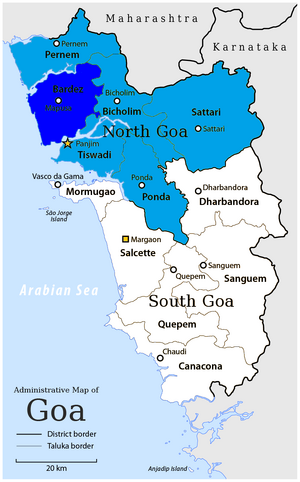Mormugao
| Author:Laxman Burdak, IFS (R) |

Mormugao (मोरमुगांव) is a city and tahsil in the South Goa district of Goa, India. It has a deep natural harbour and is Goa's chief port.
Variants
Location
Jat clans
History
When the Portuguese colonised part of Goa in the sixteenth century, they based their operations in the central district of Tiswadi, notably in the international emporium 'City of Goa', now Old Goa. As threats to their maritime supremacy increased, they built forts on various hillocks, especially along the coast. In 1624, they began to build their fortified town on the headland overlooking Mormugao harbour.
The sultans of Bijapur, who had ruled Goa before the Portuguese, did not give up easily. There were several invasions. From the sea came the Dutch, who eventually took over from the Portuguese most of the coastal settlements: the Moluccas, Batticaloa, Trincomali, Galle, Malacca, Manar, Jaffna, Quilon, Cochin and Cannanore. From 1640 to 1643, the Dutch tried their best to capture Mormugão but were finally driven away.
In 1683, the Portuguese in Goa were in grave danger from the Marathas. Almost certain defeat was averted when Sambhaji suddenly lifted siege and rushed to defend his own kingdom from the Mughal Emperor Aurangzeb. The narrow escape, no less than the decline of the City of Goa, convinced the Portuguese viceroy, Dom Francisco de Távora, that he should shift the capital of the Portuguese holdings in India to Mormugao's formidable fortress.
In 1685, the new city's principal edifices were under construction, with the Jesuit priest Father Teotónio Rebelo in charge. The Jesuit architects made a consistent effort to avoid the ornate style of the time. The austere viceregal palace still stands, having been used, after its short stint as a palace, in various capacities, including as the hotel which housed the British agents who in 1943 destroyed German ships anchored in Mormugao's neutral waters. Viceroys after Távora found Mormugao too secluded for their liking. The administrative headquarters were moved to the new city of Panjim, which is till today Goa's chief city.
During World War II, the harbour of Mormugao was the site of Operation Creek, which resulted in the bombing of a German merchant ship, Ehrenfels, which had secretly been transmitting information to U-boats.[1]
List of Villages in Mormugao
1. Arossim, 2. Cansaulim, 3. Chicalim, 4. Chicolna, 5. Cortalim, 6. Cuelim, 7. Dabolim, 8. Issorcim, 9. Pale, 10. Quelossim, 11. Sancoale, 12. Sao Jacinto Island, 13. Sao Jorge Island, 14. Velsao,

